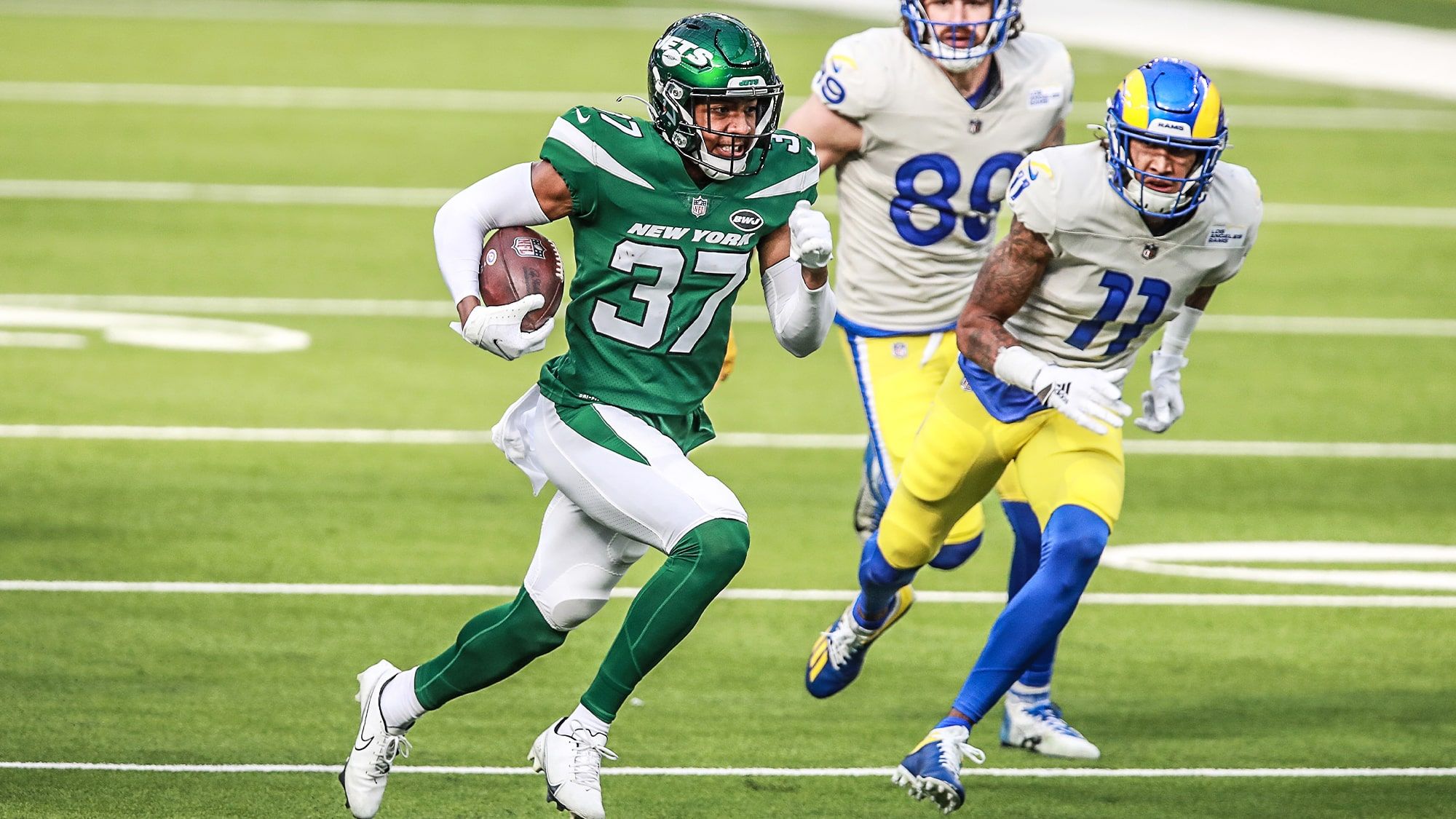New York Jets rookie cornerback Bryce Hall faced a gauntlet of stud wide receivers to begin his NFL career. How did he fare?
Due to his recovery from an ankle injury that he suffered at the University of Virginia late in the 2019 season, New York Jets rookie cornerback Bryce Hall did not even participate in an NFL practice until Oct. 22, 2020. Nineteen days later, he made his first NFL appearance, and 13 days after that, he made his first NFL start.
Hall’s primary matchups in that start? Keenan Allen and Mike Williams, one of the league’s mere five duos of 1,000-yard receivers in the 2019 season.
Good luck, rook.
There was no honeymoon period for Hall following his placement into the Jets’ starting lineup, as he immediately was tested by some of the best receivers in the game week after week.
Was Hall up to the challenge of his rookie-year gauntlet? Let’s dig into his coverage numbers against each and every player he matched up against in 2020.
Shown below is a chart that includes Hall’s production versus every receiver he saw at least one target against.
Five numbers are listed for each receiver:
- The receiver’s career average for yards per target
- Hall’s number of targets and receiving yards allowed to the receiver
- The expected number of receiving yards Hall should have allowed to that receiver (receiver’s yards-per-target average multiplied by the number of targets they saw against Hall)
- The net difference between Davis’s actual receiving yardage total against the defender and his expected receiving yardage total
Looking at some of the names on this list and how Hall fared against them, Jets fans should feel very excited about his long-term potential:
Overall, Hall was very close to average. He gave up 352 yards instead of the 349-yard expectation based on the career production of his opponents. On a per-target basis, Hall coughed up 8.0 yards versus an expectation of 7.9. Not too shabby. Any team would eagerly accept an average level of performance from a rookie cornerback who spent the majority of the past year rehabbing a serious injury and then made his first start mid-season about one month after his first practice.
Against wide receivers, Hall was solid, allowing 246 yards on 7.2 yards per target versus an expectation of 276 yards on 8.1 yards per target.
Hall’s issues came against non-wide receivers, to whom he allowed 106 yards on 10.6 yards per target versus an expectation of 73 yards on 7.3 yards per target. The vast majority of the damage came courtesy of Las Vegas Raiders tight end Darren Waller, who scorched Hall for four catches and 65 yards over five targets.
There is a lot to like about the track record that Hall put together against his toughest matchups. Against Keenan Allen, Mike Williams, Robert Woods, Nelson Agholor, D.K. Metcalf, Tyler Lockett, and DeVante Parker, Hall allowed 129 yards on 6.5 yards per target versus an expectation of 171 yards on 8.6 yards per target, netting the Jets plus-42 yards on plus-2.0 yards per target.
Hall was marvelous in his first start against the Chargers, allowing 29 yards on eight targets to the Allen/Williams duo. Jets X-Factor’s Robby Sabo and James Wighaus have each done extremely in-depth film breakdowns on the impressive potential that Hall showcased in that game, which can be found here and here.
The wideout who gave Hall the most trouble was DeVante Parker in Week 12. Parker caught four of his six targets against Hall for 58 yards, with all four catches going for a first down.
Looking at Hall’s production in terms of conversions (first downs or touchdowns), he gave up 19 conversions on the season (17 first downs, 2 touchdowns) compared to an expectation of 17.0. Coming over 44 targets, Hall’s allowed conversion rate of 43.2% was a minus-4.6% margin versus the 38.6% rate he would have been expected to allow based on the career conversion rates of his matchups.
While Hall posted great numbers against wide receivers in terms of yardage, he was below-expectation against the position in terms of conversions, yielding 14 conversions on a 41.1% rate versus an expectation of 13.0 conversions on a 38.2% rate.
Hall’s conversion numbers are a bit worse than his yardage numbers. This is because he allowed a decent amount of short first downs that did not hamper his yardage numbers but still moved the chains. For example, his one catch allowed to D.K. Metcalf went for only five yards, but it was a touchdown. Hall gave up a decent number of these short first downs. On the plus side, he did a nice job of preventing huge gains, which explains why he was better in the yardage department. Hall gave up only one completion of over 25 yards and only two of over 20 yards.
Still, allowing merely two more first downs over a half-season span than you would expect the average cornerback to give up is plenty good for a cornerback in Hall’s shoes. That’s competent production. The Jets and their fans should feel excited about the fact that Hall performed competently in a rookie season where all of the odds were stacked against him.
Hall posted an overall coverage grade of 62.9 at Pro Football Focus, which is above the 2020 cornerback average of 61.0 and ranked at the 56th percentile among the 141 cornerbacks to play at least 200 snaps. Being right around average is great for a rookie cornerback. Hall’s coverage grade was the fourth-best mark among qualified first-year corners, trailing only L’Jarius Sneed, Cameron Dantzler, and Trevon Diggs. No other qualified rookies beyond those four had an above-average coverage grade.
Nobody would argue that Hall was a lockdown force in his rookie season, but he was certainly an okay starter. And that’s a tremendous foundation for him to build his career off of.



